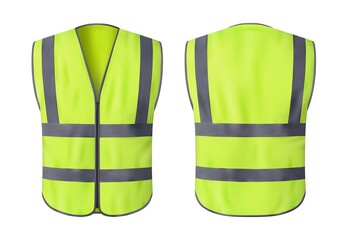In our bustling world where safety is paramount, safety vests play a crucial role in safeguarding workers and individuals in various environments. Whether you're on a construction site, directing traffic, or enjoying a night-time jog, the importance of safety vests cannot be overstated. Let's delve into the world of safety vests, exploring their significance, types, and tips for choosing the right one.
Why Safety Vests Matter:
Safety vests are not just reflective clothing items; they are lifesavers. By enhancing visibility, they reduce the risk of accidents, especially in low-light conditions or high-traffic areas. For workers, wearing a safety vest isn't just a requirement; it's a proactive measure to mitigate potential hazards. Whether it's identifying personnel on a construction site or ensuring pedestrians are visible to drivers, safety vests play a crucial role in accident prevention.
Types of Safety Vests:
-
Class 1 Safety Vests: Ideal for low-risk environments with minimal traffic speeds, such as parking lots or warehouses. These vests offer basic visibility enhancement with minimal reflective tape.
-
Class 2 Safety Vests: Designed for moderate-risk environments, including construction sites, where workers are exposed to traffic moving at speeds below 50 mph. They feature more reflective material and fluorescent background fabric, providing increased visibility.
-
Class 3 Safety Vests: Offering the highest level of visibility, these vests are suitable for high-risk environments such as highways or road construction zones. With ample reflective tape and fluorescent material, they ensure maximum visibility, even in adverse weather conditions.
-
Specialty Safety Vests: Tailored for specific industries or tasks, these vests include features like flame resistance for firefighters or cooling properties for workers in hot climates. They address unique safety concerns while maintaining high visibility.
Choosing the Right Safety Vest:
When selecting a safety vest, consider the following factors:
-
Visibility Requirements: Assess the environment where the vest will be worn and choose the appropriate class based on the level of risk and traffic speed.
-
Fit and Comfort: Opt for vests with adjustable straps or stretchable fabric to ensure a comfortable fit for prolonged wear.
-
Material and Durability: Look for vests made from high-quality, durable materials that can withstand the rigors of the work environment.
-
Additional Features: Depending on your needs, consider features such as pockets for storing small tools, ID badge holders, or breathable mesh panels for ventilation.
-
Compliance: Ensure that the safety vest meets relevant safety standards and regulations, such as ANSI/ISEA standards in the United States or EN standards in Europe.
Caring for Your Safety Vest:
To prolong the lifespan and effectiveness of your safety vest, follow these care tips:
-
Regular Inspection: Check for signs of wear and tear, including frayed edges or faded reflective tape, and replace the vest if necessary.
-
Cleaning: Follow the manufacturer's instructions for washing the vest to maintain its visibility and durability. Avoid using harsh chemicals or bleach, as they can damage the reflective material.
-
Storage: Store the safety vest in a dry, well-ventilated area away from direct sunlight, heat sources, or chemicals that could degrade the fabric or reflective properties.
-
Replacement: Replace the safety vest if it becomes damaged or no longer provides adequate visibility, ensuring continued safety on the job.
Conclusion:
Safety vests are not just garments; they are essential tools for protecting lives and preventing accidents. By understanding the different types of safety vests, choosing the right one for your needs, and properly caring for it, you can enhance visibility and safety in any environment. Whether you're a construction worker, cyclist, or pedestrian, wearing a safety vest is a simple yet effective way to stay safe and visible in any situation.


No comments yet